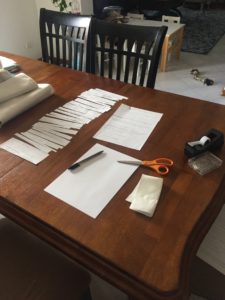My weird process for editing dialog
Editing dialog. It’s a process that every book has to undertake and I decided this past week that it was time for my latest novel to be on the chopping block. This analogy is very accurate because I literally cut my characters’ conversations apart and examine each line individually.
I’ve done this for every book I’ve written but I didn’t realize until the past weekend that my method looks rather strange. (something my husband pointed out when he saw our dining table covered in strips of paper)
I know that it looks weird but I can assure you, it’s a method that works, and I’m going to walk you through it.
Step 1: Copy the conversation into a separate document. It doesn’t matter how many people are talking.
Step 2: Delete everything that’s not in quotations. This is CRUCIAL and the point of the entire process! Delete all mention of body language (His eyes went wide in surprise.), all details about who’s speaking and their tone (Reus answered angrily,), and all inner thought (She must be crazy!). All that remains will be what the characters actually said aloud to each other.
Step 3: Widen the spacing in between lines, narrow the margins, and print.
Step 4: Cut each statement apart, making sure that if a character speaks for multiple lines- keep those lines together. Also make sure to keep each scene (or conversation) separate. I use paperclips to make sure they stay organized.

My process for editing dialog
Step 5: Mix up the strips of dialog and edit each one individually. Without the extra words surrounding it, what the character actually says will be much more apparent.
Step 6: Reassemble the strips to make the conversation. Keep in mind that they’re probably going to be reassembled differently than you had originally written them. This is the point of the exercise! In looking at each line individually you’re able to weed out the conversational fluff. Each conversation should have a point and help to move the story along.
Step 7: Tape the pieces together. I like to take a blank piece of paper (usually from our recycling bin) and tape the strips onto it in their new order.
Step 8: Using your new, better version, of the conversation as a guide, edit your manuscript. You’ll be amazed at how much it changed! When you’re finished, (obviously) read back over the entire thing and make sure the body language, inner monologue, etc. looks correct.
I understand that this technique won’t work for everyone but I find that each time I do it, it makes my writing stronger!
If you’re an author, what techniques do you use to edit your manuscript? Comment below!

Comments (0)